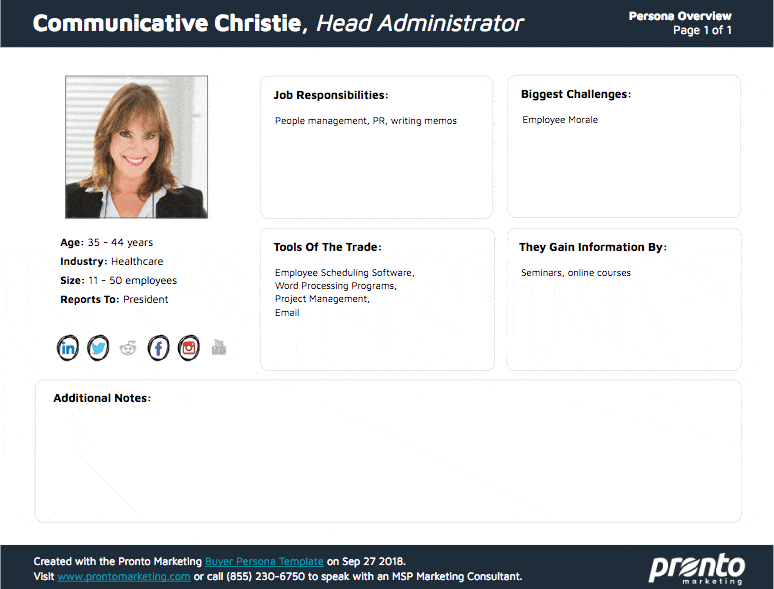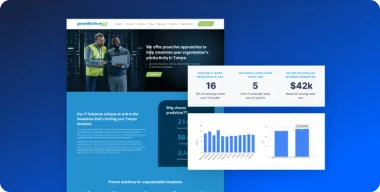Who are your ideal customers? I’m not talking about their job titles or the number of computers in their office. When you really think more deeply about the people you’d like to attract to your business, what are their specific needs and desires? What sort of questions do they ask during the sales process and what sales materials really resonate with them?
The truth is, if you don’t know specifically who you’re trying to attract, then your website and marketing materials are less likely to engage with your ideal customers. At the end of the day, you’re marketing to individual people. If you’re not speaking to someone, you’re very likely not speaking to anyone. That would mean you’re flying blind, creating content that doesn’t resonate with the core needs of the people you most want to engage.
How To Define Your Audience
The first step to improving your marketing is to define who you’re marketing to by developing buyer personas. Buyer personas are profiles that outline the backgrounds, goals, and challenges of each of your ideal customers. A buyer persona isn’t a direct photocopy of an existing client, but rather an imaginary character that is based on a subset of your customer base.

The problem is, it can be difficult to know where to start. That’s why Pronto has developed a Buyer Persona Template.
Free Buyer Persona Template
This interactive tool that guides you through the process of creating personas by asking the questions that matter most. You’ll be surprised at how easily and quickly you can create buyer personas to define your target audience.

All you have to do is answer a short questionnaire containing multiple choice and open-ended questions. When you finish the questionnaire, you’ll receive a single-page PDF in your email that’s ready to share and use to guide your marketing efforts.
Buyer Persona Template Process
Using the persona template tool is simple. To get started, follow the below steps:
Step 1: Complete the Questionnaire
We’ll ask you several questions about your ideal customer related to their job title, job responsibilities, biggest challenges, and pain points. This information will allow you and your organization to create specific recommendations to guide your blog writing, email strategy and much more.
A big part of this process is to really get to the root of who this person is. That’s why we start by asking you for gender and to select a photograph that best represents them. We also encourage you to give them a name to personify the profile you’ll be marketing to.

If you’re not sure how to answer questions about gender, age, or industry, take some time to evaluate your customer database or speak with your field sales team – what do they notice when in sales conversations? Who are the decision makers most likely to be involved?
It’s tempting to try and complete the questions as quickly as possible. However, the more accurate the information you provide, the more valuable your persona will become. An accurate persona will provide the insights you need to market to real people, not just a number on a spreadsheet.
After completing the profile, make sure to provide a valid email address where we can send the results.
Step 2: Receive your buyer persona via email
You’ll receive an email in 10-15 minutes with a link to a two-page downloadable PDF. You’ll also receive editable versions in PowerPoint (pptx) and OpenDocument (odp) formats.

Your customized persona will have everything you’ve entered, along with specific recommendations that can help get you started on your marketing and targeting efforts.
Tip: This is also a good time to go back to the Buyer Persona Template and create additional personas. If you market your services to individuals in different industries, with different personality types, and holding different jobs, it will be beneficial to create at least 3-4 personas.
Step 3: Review and update your buyer personas
There may be some questions that you didn’t answer fully or that could use further expansion. That’s why it’s important that you share the documents with other stakeholders who can help to flesh out those topics and provide additional insights.
The goal of this exercise is to put a face and a name on the sales and marketing efforts you undergo. It’s easy to look only at the numbers behind your efforts and not take into consideration the people and their real concerns and issues that you’re engaging with.
Step 4: Share and adapt your buyer personas
Share your buyer personas with everyone in your organization who communicate with customers. Everyone needs to be on the same page about who you are targeting and how to best engage with them.
Here are a few ideas:
- Make the personas part of your style guide and marketing and sales communication guidelines so that they are always considered when content is created.
- Place your personas in the office where people can see them. Print and place these personas on the walls to remind everyone of who they are working with.
- Discuss personas in meetings with all of the people who engage at a marketing or sales level with potential customers.
Getting the Most Out of Your Buyer Personas
Think of your buyer personas as living documents. They should always be growing and adapting based on new information. If the market is changing, make revisions to your buyer personas. If you’re targeting a new industry, create a new buyer persona with the ideal customer you’re targeting.
If used correctly, buyer personas can have a tremendous impact on your marketing efforts and your bottom line. Just remember that you have to use your personas actively and always think about them when you’re creating your marketing campaigns.
Alright, you’ve reached the end. What are you waiting for?





